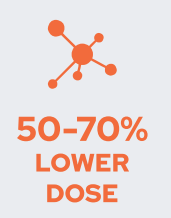Comparison of PET/MR and PET/CT techniques
Positron emission tomography (PET) examinations are performed on two types of scanners, which are equipped with an auxiliary modality, i.e. computed tomography or magnetic resonance imaging. The older and more widely available technique is PET/CT (positron emission tomography with computed tomography). Such devices are available in most large urban centers. In 2011, the first PET/MR examination was performed in Geneva, in which two examinations are performed simultaneously, i.e. PET and magnetic resonance imaging. Below we present the most important differences in these techniques. We also encourage you to follow the news in which we publish the latest scientific reports.
PET/MR vs PET/CT
| PET/MR | PET/CT | |||
|---|---|---|---|---|
Scope of the examination |
|
| Both examinations consist of a full-body scan | |
Multi-parametricity |
 | - | PET/MR is two examinations in one, in contrast to the classic PET/CT examination | |
Examination precision |
| - | More possibilities thanks to multi-parametricity | |
Radiation dose |
 | - | Significant reduction of ionizing radiation dose in PET/MR examination | |
Exposure to pain/patient's comfort |
|
| Both examinations are safe and painless for the patient | |
Refund | - |
| Only PET/CT examinations are reimbursed by the National Health Fund | |
Contraindications |
|
| Metal foreign bodies are contraindications in magnetic resonance imaging |
Both PET/MR and PET/CT are whole body scans. Due to the patient’s comfort, examinations usually cover the area from the top of the head to the middle of the thighs. If necessary, the doctor decides to extend the scope of the examination to the lower limbs.
In the PET/MR examination, a PET examination and a fully diagnostic magnetic resonance imaging are performed at the same time. In this way, the patient receives two examinations, which are additionally overlapped. A fusion image is created that can provide additional information for the describing doctors. In the case of PET/CT, computed tomography is only an auxiliary examination used to positioning the patient.
Thanks to the multi-parameter nature of PET/MR, doctors receive more information. Studies on a large patient population indicate that up to 15% more lesions were located during PET/MR than in the same patients during PET/CT. More in the news.
The PET/MR examination is characterized by a much lower dose of ionizing radiation, because there is no magnetic resonance radiation, in contrast to PET/CT examinations. In both examinations, the patient receives a small dose of radiation from a radiopharmaceutical. In the PET/CT examination, the patient additionally receives a dose of radiation from computed tomography, which is responsible for at least 50% of the total dose absorbed by the patient. In our laboratory, it is possible to combine both techniques and perform examinations after a single administration of a radiopharmaceutical. More in the news.
Both examinations involve only a puncture for intravenous administration of the radiopharmaceutical and discomfort associated with the length of the examination. The examinations are painless for the patient.
Only PET/CT examinations for strictly defined medical indications are reimbursed by the National Health Fund. The innovative PET/MR examination is not reimbursed in Poland or Europe. They can be made commercially or as part of scientific projects carried out in our laboratory.Pregnancy is a contraindication for both PET examinations. In addition, in the case of PET/MR examinations, there are limitations related to the magnetic field, i.e. having metal foreign bodies in the body.




